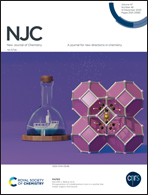Adsorption of solid phosphines on silica and implications for catalysts on oxide surfaces†
Abstract
Tertiary phosphines are ubiquitous in inorganic chemistry. They play important roles as ligands in coordination chemistry and catalysis. Furthermore, they act as surface acidity probes for oxide surfaces. However, only volatile phosphines, such as PH3 have been applied in this function so far. Here we demonstrate for the first time that the triaryl- and trialkylphosphines PPh3 and PCy3 with high melting points self-adsorb readily onto a silica surface even in the absence of a solvent. The self-adsorption takes place within days when both solid components are mixed and then left undisturbed. The phosphines form well-defined monolayers on the surface and the transition from monolayer to left-over polycrystalline phosphine is abrupt. Therefore, the maximal surface coverage with a monolayer can be easily determined. When the phosphines are adsorbed from solutions, the same maximal surface coverage is found. Solid-state NMR spectroscopy provides a unique analytical tool for studying the structure and dynamics of phosphines in different environments. 31P and 2H solid-state NMR measurements are successfully applied for characterizing the adsorption process and the mobilities of the adsorbed phosphines across the silica surface. Furthermore, using (Ph3P)2Ni(CO)2 as a representative, it is demonstrated that the silica surface has a hitherto unrecognized impact on immobilized and surface-residing catalysts because it competes for phosphine ligands coordinated to a metal center. This competition manifests as one more factor leading to the loss of phosphine ligands and ultimately leaching of immobilized metal complexes or nanoparticle formation. Besides the increase of fundamental knowledge about adsorption processes, the presented results have implications for chromatographic separations of metal complexes and for the lifetime of immobilized and other types of surface-residing catalysts.



 Please wait while we load your content...
Please wait while we load your content...